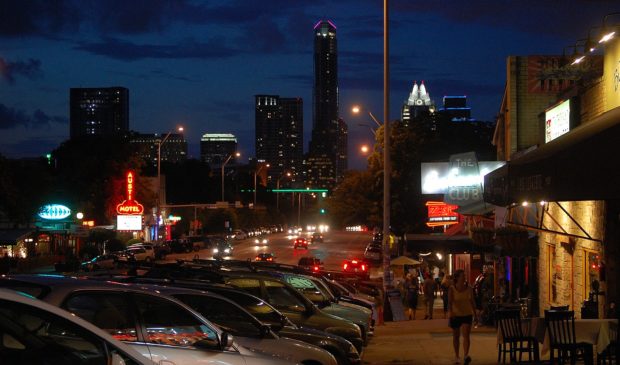Report: West Campus needs more lights
Tuesday, December 4, 2018 by
Jack Craver Two and a half years after the murder of a UT student spurred calls to improve safety in the West Campus neighborhood, campus safety advocates and city transportation officials say it’s time for the city to improve lighting in the area.
Last year, the city hired a consultant to do a comprehensive study of existing streetlights in West Campus. Of the roughly 1,100 lights in the neighborhood, about 20 percent were deemed “deficient” in some way, said Joel Meyer, who oversees pedestrian safety for the Austin Transportation Department, in a presentation Monday evening to the Public Safety Commission.
Some lights are out. Some are too dim. Many others are obstructed by tree branches.
In addition to replacing deficient lights and trimming tree branches that are in the way, the consultant recommended adding 228 new lights.
The Transportation Department has engaged in a variety of stakeholder engagement processes aimed at understanding how to help the predominantly student residents of the area to stay safe walking the streets at night. An online survey of residents that generated 400 responses showed that only one in five believed lighting was adequate, while 93 percent said that increased lighting would make them feel safer.
Poor lighting not only makes students more vulnerable to crime, said Meyer, but puts them in greater danger of collisions with cars, cyclists and the increasing number of people traveling on scooters.
Meyer said that the Transportation Department is preparing a recommendation for City Council action in the coming weeks to identify funding to add the new lights. The lights alone would cost an estimated $580,000, but the necessary engineering, design and wiring costs will likely bring the price tag to $1.7 million-$2.3 million.
Joell McNew, the head of Safe Horns, a group founded in the wake of the murder of 18-year-old Haruka Weiser in April 2016, told members of the commission that the city needs to do much more to assure the safety of students. Adding lighting is a crucial first step, she said.
“We strongly believe in the broken windows theory,” she said. “Crime prevention by environmental design is very critical.”
Commissioner Ed Scruggs noted that West Campus has undergone tremendous growth in recent years. An area characterized by single-family homes – often subdivided into student apartments – is increasingly dominated by large apartment buildings targeting student renters. The new urban landscape may demand new lighting strategies, he suggested.
Commissioner Kim Rossmo, noting his own background in environmental criminology, noted that in many U.S. cities, street lighting is designed with vehicles, rather than pedestrians or cyclists, in mind.
Meyer agreed, saying that redesigning lighting through a multimodal transportation lens is something that transportation officials are considering. In the meantime, however, the installation and maintenance of existing streetlights is the responsibility of Austin Energy, which remains focused on traditional street lighting techniques.
Allen Small, Austin Energy director of distribution, said that the utility tries to trim tree branches that are obstructing lights as quickly as possible. However, this is more challenging in an area as dense as West Campus, he said.
“It is a tight area. The streets are pretty narrow. With the amount of UT students … it kind of hinders our trucks getting in,” said Small.
“It seems like the lighting fixes are very low-hanging fruit,” said Chair Rebecca Webber. “It just seems so obvious to me that we do that.”
Photo by Eagleamn at en.wikipedia [CC BY-SA 2.5], via Wikimedia Commons.
The Austin Monitor’s work is made possible by donations from the community. Though our reporting covers donors from time to time, we are careful to keep business and editorial efforts separate while maintaining transparency. A complete list of donors is available here, and our code of ethics is explained here.
You're a community leader
And we’re honored you look to us for serious, in-depth news. You know a strong community needs local and dedicated watchdog reporting. We’re here for you and that won’t change. Now will you take the powerful next step and support our nonprofit news organization?











